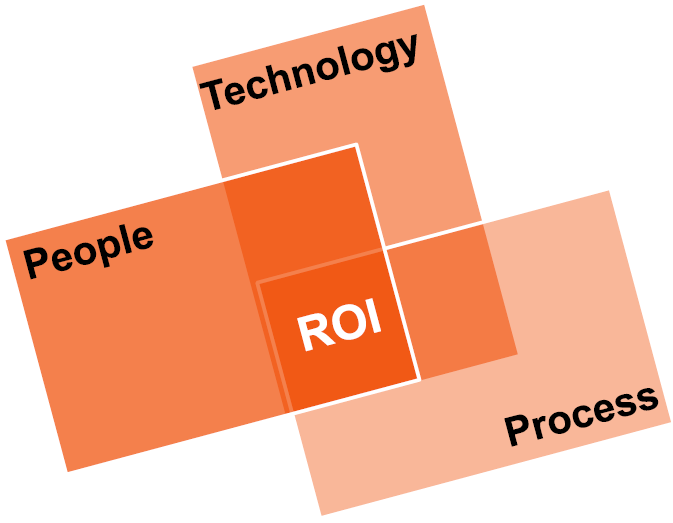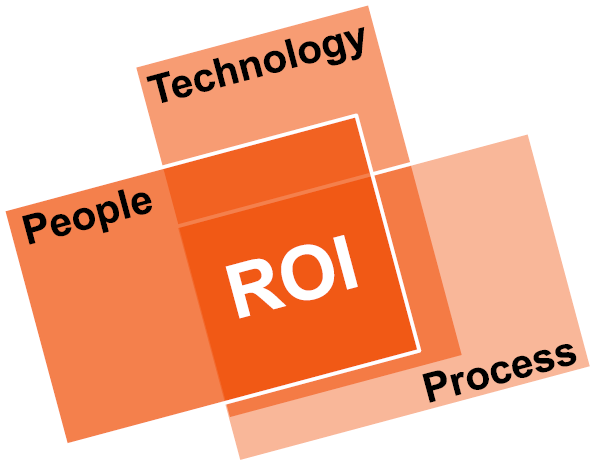You’ve made the decision – you’ve undertaken a system integration project to more tightly align People, Process, and Technology. What's your best bet to capitalize on a successful implementation?

For over 28 years, our projects have all involved some aspect of aligning People, Process, and Technology (PP&T) for better business results (represented by ROI).

Before
LOW Alignment of PP&T
Our job is to improve the alignment of these "building blocks" to enable the company to perform better – and when we do, then costs melt, cycle times shrink, and quality goes up. (For more on this, see 3 Ways to Grow Your Bottom Line and Todd's Hypothesis, Part Three.)

After
HIGH Alignment of PP&T
On several occasions, we've been retained by clients to use Technology to reduce the workload of their People. We've seen this play out in several different ways, depending on:
- The company's situation – whether it's looking to reduce costs (frequently in the face of stagnant or declining revenues) or wanting to avoid future costs (when growth is in the business plan).
- The peoples' skills – whether these are easily replaced by technology (such as data entry for Accounts Payable) or are difficult to displace (helping customers troubleshoot issues).
Whether you’ve decided on us or another firm, what skills would help position your company to capitalize on a system integration project? I believe having employees possessing one – and preferably both – of the following skills are essential.
- Emotional Intelligence – often abbreviated EQ (for Emotional Quotient, to parallel the IQ of Intelligence Quotient
- The 3 C’s: Critical Thinking, Creative Thinking, and Communication – although the 3 R’s (Reading, wRiting, and aRithmetic) were fundamental to success in the 1900’s, the 3 C’s are now superseding them as modern-day success factors.
Let me share a few examples.
Why EQ Is Important – Good Process and Technology Allows Peoples' EQ to Shine
A client project was recently rolled out company-wide. This system integration project was undertaken not to cut staff costs. Rather, it was undertaken to enforce margin requirements, improve employee productivity, provide visibility of both potential opportunities and customer orders – and create a repeatable and scalable process to use as new branches are opened. All of these goals are either being achieved or will soon be achieved.
And the best part? The great majority of employees benefiting from better productivity are customer-facing, allowing them to spend LESS time on paperwork and tedious tracking, and MORE time applying their EQ skills to convert prospects and keep customers happy.
This fits in well with management’s overall vision of creating an "extraordinary experience” for the customer:
- When a potential customer walks into the store, she is promptly greeted and helped.
- A designer works with the prospect to envision the kitchen or bath remodeling project, then uses a CAD application to layout the project.
- The system uses this information to cost the project and prepare a quote – the designer reviews the quote, then has the system send it to the prospect.
- Quotes are tracked by the system on a dashboard for follow-up and conversion.
- Once the customer accepts a quote, the system converts it into an active job, then creates POs for the various suppliers and subcontractors.
- After suppliers and subcontractor confirm dates, these become the project schedule in the system and are communicated to the customer.
- Progress is tracked against the project schedule and periodically communicated by the system to the customer, using her preferred form of communication.
- Once the remodeling work has begun, progress is monitored daily by a project coordinator to ensure the work is done promptly and accurately, to minimize disruption to the homeowner.
- The project coordinator compiles any punch list items, then lets the customer know when they will be performed.
- Overdue invoices are an indicator of potential customer dissatisfaction – these are monitored daily through the system, with escalating follow up until any issues causing the customer to withhold payment are resolved.
This kind of experience is what our client wants EVERY ONE of its customers to have, and thus promote goodwill, referrals, and “word of mouth” advertising.
Notice how the integration system works unobtrusively to push the process along, establish clear accountability for tasks and dates, and provide alerts and dashboard indicators so potential issues are nipped in the bud. The system handles the mechanics, allowing the designers, project coordinators, and store managers to focus their attention and EQ skills on the customer.
Why EQ Is Important – Poor Process and Technology Dooms Survivors' EQ and Costs Customers
Contrast our client’s experience with my own firm’s experience with a new service provider.
About two years ago, I decided to replace a service provider I'd used for many years. Even though this company’s service to my firm was good, the costs seemed too high, given the relative simplicity of what was being done. Thus, I went with a new provider, whose sales rep claimed – you guessed it – lower cost via easy-to-use self-service processes, and strong support via a person available by phone or email to troubleshoot problems and resolve issues.
The conversion of this service was VERY bumpy – still, I didn't mind this too much, since most conversions, regardless of the type or quality of system, have inevitable "gotchas." The problem came when it came time to actually USE the service and my experience was HORRIBLE!! After surviving the first year, I told the provider the second year HAD to go better or I'd be leaving them.
The second year's usage of the service DID go better at first ... and then things stalled. Once things did get back on track, the turnaround time was TERRIBLE and the first three sets of results were FRAUGHT with obvious errors. The fourth set of results were questionable, though I deemed them “good enough.” Thus, I decided to live with these results – and find another provider.
Keep in mind, I had done my "due diligence" in checking references for this new provider, and they were good. So what happened? About the time I came on board, this company decided to roll out a new technology platform and force its customers to take on responsibilities previously done by its staff. The problem – the new technology basically put lipstick on a pig, and was not intuitive, user-friendly, or even browser-friendly.
The company also eliminated a large percentage of its customer service reps (CSR's), handed out 7-digit extension codes to employees, and eventually removed phone extensions from employees' email signature lines. The message this sent to customers? "We want to make it as HARD as possible for you to get someone on the phone, no matter what." I guess they saw no business benefit in having satisfied customers.
What's the lesson? Actually, a few:
- Management decided to let go of the people who had the BEST EQ skills – the CSR's – leaving behind overworked people with low EQ.
- System projects integrating people, process, and technology take time to correctly design, develop, test, and rollout – all of which stand in the way of management looking to quickly cut staffing costs, regardless of consequences.
- Although I pointed out the service issues of this provider several times, they weren’t listening to their customers, leaving me to conclude, "You can't fix stupid."
Why the 3 C's Are Important
In the preceding examples, choices of process and technology either maximized the strong EQ of good people, or overwhelmed the low EQ of the remaining people.
Process and technology changes also test peoples’ 3 C’s – especially in jobs involving large volumes of paper or large amounts of data entry, which are prime targets for process re-engineering.
Over the years, we've done several integrations of an MRP (Materials Requirements Planning) system with a financial system. Such integrations can give the benefits of an ERP (Enterprise Resource Planning) system, with a much lower risk of implementation failure. Accounts Payable is always an area where much of the grunt work is taken over by the system.
The implication? The integrated system no longer requires Accounts Payable Clerks – rather, it requires Accounts Payable Analysts. A "Clerk" can't always make the transition to "Analyst" because the latter position monitors the operation of the integrated system and shifts into troubleshooting mode when something doesn't process correctly.
Guess what skills are important for people to successfully troubleshoot issues?
-
Critical Thinking, to understand how the system is supposed to process transactions.
-
Creative Thinking, to play out "what if" scenarios and envision how a scenario MIGHT be processed incorrectly by the system.
-
Communication, to describe findings and recommendations.
We're currently courting a potential client having several employees whose main duties are to pick up papers off the fax machine throughout the day, key certain results into a Word template of their standard report, and then either fax or postal mail a printout, or email a PDF, of the report to the customer. Very little thinking is involved, and communications with the customer are limited. We estimate we can eliminate about 60% of the work done by these employees. Once the “fig leaf” of paperwork is removed, the employees will have to differentiate themselves by their 3C’s skills.
What to Do as a Company?
Differentiating your company from your competitors is more important than ever, since competitors can come from any direction, at any time. What are your basic competitive options? In Strategy Maps: Converting Intangible Assets Into Tangible Outcomes, by Robert S. Kaplan and David P. Norton, the authors list three strategic “themes” – my comments follow the themes and example companies:
- Operational Excellence, as exemplified by Wal-Mart – This requires running all aspects of your operations more efficiently and more effectively than your competitors, typically resulting in being a low-cost provider.
- Customer Intimate, as exemplified by Nordstrom – This requires deep relationships with, and clear understanding of, your customers, allowing you to anticipate their needs even before they do.
- Product Leader, as exemplified by Nike – This requires a sustained investment in research and development, then quickly turning new ideas into marketable products.
Few of us will ever have the resources to compete like Wal-Mart, Nordstrom, or Nike. The good news? You don’t have to! YOU only have to pick and focus on a few aspects of these strategic themes, then deliver on these key things better and more consistently than YOUR real-life competitors, not some hypothetical competitors in a business book.
Need help finding, focusing on, and then implementing improvements in a few key areas, to distinguish your company from others in your industry? We’ve done it for our clients, so please call or email me, and let’s discuss whether we could do the same for you.
Sincerely,

Todd L. Herman
Suggested Resources
Regardless of whether or not you see aspects of your company (or yourself) in the preceding scenarios, recognizing the importance of EQ and the 3 C's is invaluable to your company and your career. I’ve compiled this list of resources you can use to assess your employees’ (or even your own) EQ and 3 C's skills – and then begin to work on areas for improvement.
- For EQ, here are some books I’ve found useful over the years:
- The EQ Difference: A Powerful Plan for Putting Emotional Intelligence to Work, by Adele B. Lynn
- The EQ Interview: Finding Employees with High Emotional Intelligence, by Adele B. Lynn
- Emotional Intelligence 2.0, by Travis Bradberry and Jean Greaves
- Leadership 2.0, by Travis Bradberry and Jean Greaves
- Emotional Intelligence: A Practical Guide, by Dr. David Walton
- For the 3 C's, I'd suggest the resources in several of my annual book reviews:






